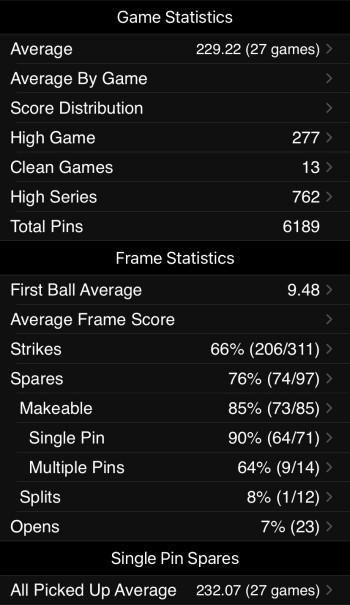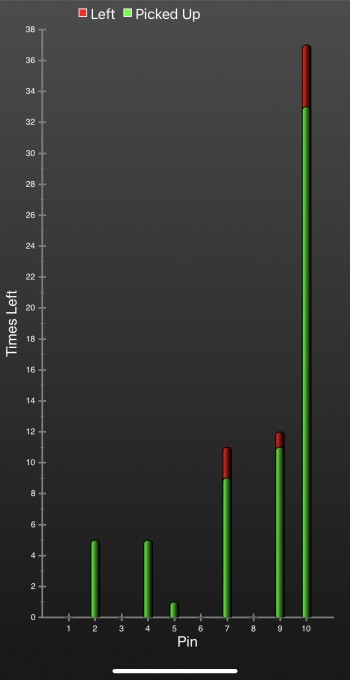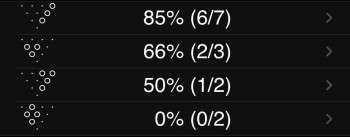First Half Wrap-Up
by Tyrel Rose | December 28, 2022 2:27 pm
With no bowling for a couple of weeks and the new year around the corner, it’s a good time to look back at how things have gone over the first half of the 2022-2023 season. Starting this blog has proven to be both distracting and beneficial. It was distracting for the first few weeks when I’d lose focus thinking about what I was going to write, instead of thinking about my actual bowling. It’s been beneficial because it really has helped me to reflect on each week, learn from my experiences, and build confidence off of the things I’ve done well.
For the purpose of this recap, we’ll follow a different format from the weekly blogs and instead do a more typical debrief-style discussion of how I’ve bowled over the course of the season. We’ll start with a quick recap of the good and not-so-good from my first 14 weeks of league.
Here’s a familiar image for those following this blog. These are my performance statistics for the first half, minus the first two weeks of the league when I wasn’t tracking yet as part of the blog.

The first half stats show that I’ve lost three pins in average due to missed makeable spares.
Overall, I’m reasonably happy with these statistics, and they align with my previous work looking at key performance factors in bowling. The key things to pay attention to are really the strike percentage, makeable spares, and overall clean frame rate. Being 93 percent clean over the course of the first half of the season is a pretty good number, but there are still a few areas we can address.
The good
- Lane play: Barring a few instances of confusion, I’m really quite pleased with how I’ve been seeing the lanes week-to-week and mostly making quick, confident adjustments.
- First ball execution: After a few weeks to shake off the rust, I’ve been pretty pleased with how I’ve thrown the ball. There will always be some errant shots, but overall, I feel I’m performing better than expected given my lack of practice.
- Pre-shot routine consistency: This is honestly an area where I’ve struggled in the past, which we saw last week. I’ve tweaked it over the years, looking for ways to be more consistent, and this year has felt very good with the exception of one or two off-nights.
The not-so-good
- Spare shooting: This has been disappointing for me, particularly for multi-pin spares.
- Lack of practice: As the year started, I’d wanted to go and practice to sharpen up my game more than a once-a-week schedule would allow, and I haven’t followed through on that.
Whereas the focus of a weekly reflection exercise like the blog posts is to highlight the positive, the point of a debrief is to address weaknesses and things that you can do differently. We still want to look at the good stuff, but a good debrief involves a deep dive into some of the issues you’ve faced and what you can do to address them. With this in mind, we’ll start by looking at our two “not-so-good” points, and finish off with the positives we want to bring forward in the new year.
Spare shooting issues
I have used the same system for shooting spares since I was a youth bowler. My spare shooting was always a strength of my game as a competitive bowler, but it’s definitely one that I’ve seen erode a bit as I’ve placed much less importance on my own bowling. Having never really tracked my statistics before, this has been a bit of a wake-up call for me.
Single-pin spares
A single-pin conversion rate of 90 percent is good, but not great. My most-missed spare is the 10 pin, which really bothers me as someone who has long considered himself a good spare shooter. Mistakes can happen, but that needs to improve in the second half if I’m going to finish the year proud of my spare shooting.

This graphic makes it easy to see what I’ve left most, and where my misses are.
Looking back week-to-week, it’s worth noting that four of the seven single pins I’ve missed have come during the first game (three 10 pins and a 7 pin). It’s not insignificant that more than half of my misses come in that game. The law of averages would indicate I miss an equal amount across the three games, so even with a small sample size, the most I should have missed is three. The implication is that I’m not quite bringing my best level of focus to start the night.
Moving forward: Bring awareness and focus from the first frame of the night. Throw spares confidently from the time the arrows come up.
Multi-pin spares
My multi-pin conversion rate of 64 percent is really bad for a bowler averaging 230. I’m not at all happy with this number. It stands to reason that multi-pin spares would be lower than single-pin spares, but my experience has been that bowlers are pretty consistently around 15 percent lower, not 26 percent lower. Looking closer, it’s clear to see where the problem is.

Even with a relatively small sample size, it’s easy to see the spare combination giving me the most trouble.
I’m converting only 40 percent of my 2-pin combinations of the 2/4/5 and 2/4/5/8. Considering that I’m 5/5 on the 2 pin when it is by itself, this is definitely something to address. I can’t say that I’m “psyched out” going for that spare, but the extremely low rate of conversion means something is up. It could very likely be a lack of focus once again, because two of the four misses for these combinations have happened in the first game. Combined with my single-pin data, this means that exactly 50 percent of all of my missed makeables are happening in the first game of the night.
There is also the added potential for complacency on a 2-pin combination because the 2 pin is an easy spare, which leads to a further lack of focus or effort. Execution-wise, there’s no reason to think that I suddenly forget how to bowl when I leave the bucket, but there is the possibility that I’m surprised by a bucket leave and I’m thinking about the adjustment for the next frame, rather than making the spare. It’s a common mistake and one I can definitely be guilty of.
Moving forward: Let go of the emotional response to the first shot, and clear the mind of thoughts about the adjustment. Focus on the spare at hand.
Lack of practice
The good news regarding some of my spare shooting issues is that a bit of practice will help clear things right up. I can build up a bit of confidence on my 2-pin combination leaves, and then leave it up to my commitment to be focused on each spare to let my conversion percentage improve.
Excuses, excuses
Here’s the thing: I actually need to go out and practice. As a coach, I know exactly how important practice is and I know the right way to practice. Where I’ve struggled the past few years is with the commitment to actually get out on the lanes and do it. There are multiple reasons for this, but they are all excuses that boil down to an important fact: my own bowling simply isn’t as important to me as it used to be.
Rightly or wrongly, I used to partially define my whole identity as a “good bowler.” Good bowlers work hard on their games. Since becoming a coach, my identity shifted to being a good coach. My own bowling quickly came second, and then third, and then fourth on my list of priorities. It’s the same story for a lot of bowlers who have jobs and families and a desire to be better. They simply often don’t feel they have the time to make that commitment.
It’s true that I don’t have the amount of time I used to have to go to the lanes and practice, and I also live farther away from my center than I ever have. But is that really what’s holding me back? Nope.
Baby steps
The first step is to find a reason to go and practice. Right now, my team is having the best year we’ve had in a long time, and I want to do what I can to continue that trend. I’ve mentioned in several blogs that focusing on my team has helped me bowl better when starting to struggle. If my own identity is no longer the thing that drives me to bowl great week in and week out, it’s time to do it for the team.
The next step is simple. Pick a day and go practice. With the holidays coming up, I can find the time. I don’t need to go and practice three or four days a week like I used to. I just need to commit a few hours of my life to something that I used to love doing. I loved being at the lanes and working on my game. Especially when the place was empty. Just me and the sound of a single pinsetter. In a 66-lane center, that’s both rare and slightly surreal. Just writing about it has me reconnecting with those old emotions.
Just do it
So here’s the commitment in writing. I will practice at least once between this blog post and when my league starts back up in January. It’s not much, but it’s a first step, and it’ll be more practice than I’ve done in at least the past 18 months.
With any luck, that first step and my focus on helping my team win will be enough to drive me to practice regularly in the second half of this season. I might not be the bowler I once was, but I’m good enough to bowl well on a house shot, and I know I can gain a few more pins every night by addressing some of the issues I’ve listed here.
Back to the positives
Having addressed what I believe are the two biggest issues I’ve faced in the first half of the year, let’s bring it back to what’s gone well. We’ll do this in the form of affirmations. Rather than simply restating the points I made above, we’ll make some positive statements that reflect those points, and reinforce the things that have been my strengths so far this year. The goal with any affirmation is to leave no “buts” at the end. Affirmations are unqualified, and they express how you see yourself and/or how you want to see yourself on the lanes:
- I love solving lane play problems.
- I’m good at making adjustments quickly and committing to them.
- I throw the ball great all the time.
- I come through in the clutch.
- I always take the time to focus before each shot.
These are the things I’ve confirmed for myself many times over the first half of the season, and they are things I know I can continue to do in the second half. Many bowlers hold themselves back by making qualified statements about their abilities. Sure, no one’s perfect, so it’s not possible to always do something well or never make a mistake, but the more we can convince ourselves of our capacity for a great performance, the better the chances we have.
Moving forward
So there it is, a deep dive into my bowling for the first half of the season, highlighting what I want to continue doing and the things I’d like to do a little better. This very closely follows the kinds of debriefs I would do directly with a bowler, but of course, everyone’s answers are different. Hopefully, readers will also find time to reflect on the first half of their season and find a few things they can commit to doing to help their bowling in the second half.
Source URL: https://www.bowlingthismonth.com/the-btm-bowling-night-blog/first-half-wrap-up/